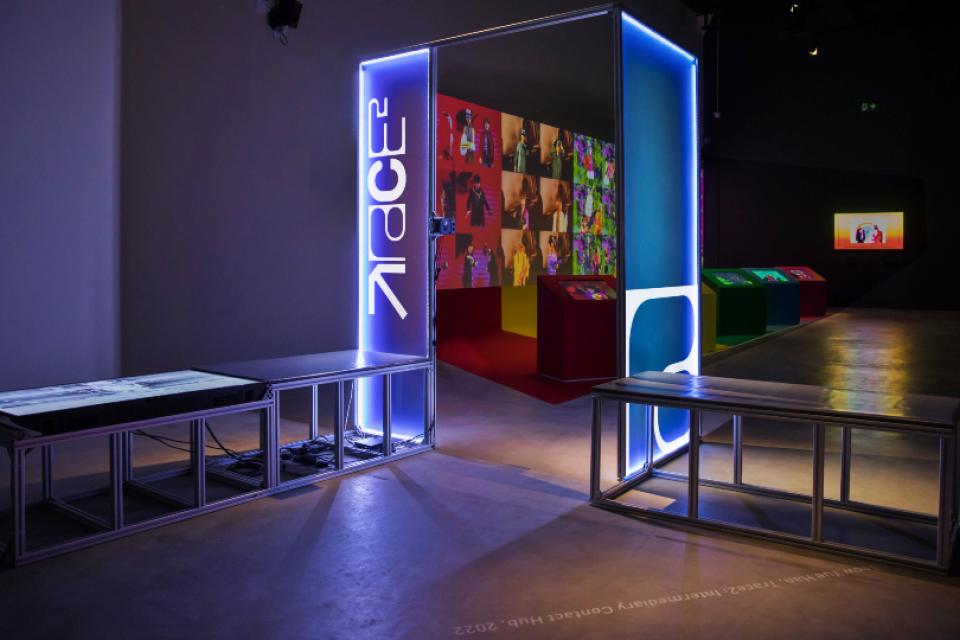Singapore Art Museum (SAM) invites visitors to explore how the bodies negotiate and connect with technology at its latest exhibition Can Everybody See My Screen?. Referencing an oft-repeated phrase that emerged from a long period of remote interactions, SAM’s new exhibition at Tanjong Pagar Distripark reflects on how the understanding of lived realities has shifted with the rise and changes in digital technologies over the last two decades.
As the title suggests, the space of the screen is central to the exhibition, acting as a portal through which experiences of the world are mediated by technology. Drawing from works created post- 2000, Can Everybody See My Screen? examines the various ways in which artistic practices engage with an increasingly digitalised world and expounds on humanity’s shared encounters with evolving technology in contemporary times.
Building upon a thematic selection, the exhibition will feature the works of local and regional artists from Indonesia, Malaysia, Thailand, and China. Seven of the 12 works presented are from SAM’s collection, reflecting the museum’s efforts to collect and engage with new mediums and modes of artmaking. These works are brought into dialogue with four commissions and one loan, presenting shifting perceptions towards technology’s impact on contemporary life.
Forging Relationships in a Hyperconnected World

In Can Everybody See My Screen?, social connectedness is explored through works that examine technology as a medium that can engender possibilities for self-identification, kinship and love. Chatchai Puipia’s 1997 painting, Windows (Love Me...Love Me Not...Love Me) offers a personal reflection on the unequal relationship underlying internet marriages while Liana Yang’s A Souvenir offers a different observation, two decades apart. Through the metaphor of a claw machine, Yang explores the role that choice and chance play in online dating and the development of romantic relationships. The work challenges visitors to win a special prize from the machine by inserting tokens into it, lending a false sense of control disguised as ‘luck’.

The P.O.P. Station Greatest Hits by KYTV (Kill Your Television) traces the journey of artist collective KYTV’s creative endeavour through a satirical response to the pop music industry and its commodification of popstars during the early 2000s, where the early beginnings of social networking sites also fuelled ordinary citizens’ desire for individuality and fame through the platform’s potential for virality.
![]()
The exhibition also examines how physical reality can be animated, reconstructed, reimagined, and immortalised in the realm of the virtual. Cao Fei’s 2007 work, i.Mirror, blurs the boundary of the real and the virtual, presenting an electronic second life as the possibility for an extended, liberated self. Avatars abound in the online space and in Terra Bajraghosa’s Narcissus Pixelus, visitors are invited to design their digital selves by using a suite of pixel swatches created by the artist.
As an alternative to the modern-day selfie, one may only obtain their avatar in printed form which encourages a second layer of interactivity – visitors are invited to leave their printed avatar for public view or exchange them with friends. The work takes the form of an arcade machine and is strategically placed at the reception area to mark its sociability.
The (in)visibility of Technological Mediation
While the electronic screen acts as an interface between the material and immaterial worlds, the presence of body and matter is a prerequisite for access to the virtual space. Visitors can look forward to interacting with works that engage their bodies and contemplate the exhibition’s exploration of technological mediation of the senses and the body.
Chong Kim Chiew’s Unreadable Wall stands in the way of an entrance to the space where the exhibition is held, forcing visitors to find an alternative access to the exhibition space. The 2013 work comprises hundreds of bricks made from shredded and pulped sheets from Malaysia’s vernacular newspapers, rendering them unreadable while acting as a screening device that forbids bodies from entry. The work thus lends itself as an ideological symbol for the disruption of free information flow and other pressures that endanger the globalised and interconnected online space. The physicality of the wall also turns attention to the corporeality of the physical body and the bodies we inhabit on the other side of a digital screen.

Several works in the exhibition also explore the use of technology as tools for social navigation. Teow Yue Han’s commissioned work, Trace2, incorporates a motion sensor-activated tracing system, triggering the appearance of a shadowy figure on a screen as visitors walk past each of the three contact hubs installed in the museum’s spaces. The work evokes the memories of TraceTogether, recalling the lingering presence of the once ubiquitous contact tracing system, raising questions on bio-surveillance and new forms of life that may emerge after the pandemic.

Urich Lau’s Life Circuit was originally conceived as a video demonstration centred around a wearable device reconstructed from industrial safety equipment. In Can Everybody See My Screen?, the work is re-presented as a multimedia installation that captures live projections of audiences through imperceptible spy cameras installed on the device by the gallery’s entrance. Lau’s work is a manifestation of technology’s mediation of human experience, reflecting on the condition of living in a technologically advanced Singapore and issues of privacy and data collection.
Can Everybody See My Screen? runs from 9 September to 11 December 2022 at SAM at Tanjong Pagar Distripark, Gallery 2. Admission is free for all visitors throughout the exhibition period. There will also be public programmes such as talks and activations by artists Urich Lau, Teow Yue Han and Liana Yang, curator tours, and craft activities suitable for all ages.
a. 39 Keppel Rd, #01-02 Tanjong Pagar Distripark, Singapore 089065
e. enquiries@singaporeartmuseum.sg
w. www.singaporeartmuseum.sg/sam-at-tpd
You Might Also Like











